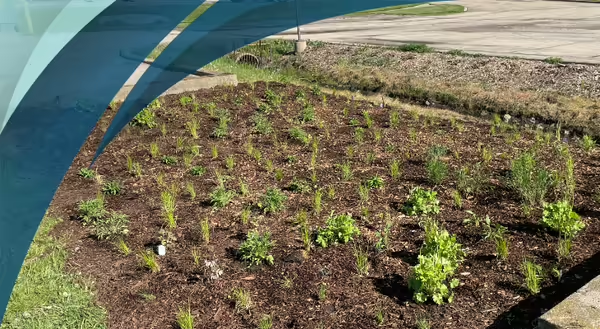
Rainwater is frequently treated like a waste product – gathered up, hustled off our yards, and into the nearest body of water. But instead, what if we kept it where it fell, used it, and directed it back into the ground. We could help mitigate flooding, conserve water, and be rewarded with a beautiful garden!
Tracing the path of a raindrop
When rain falls from the sky, it might land in a pond, on our grass, on our rooftops, or on a parking lot. These spaces are divided into “pervious” and “impervious” places. Pervious surfaces are those through which water can flow, such as gardens and turf. Impervious surfaces block the infiltration of water, like sidewalks, parking lots, and buildings. When water hits one of these surfaces, it gathers and flows to the lowest point it can find. When our infrastructure is working well, this water will travel to a storm drain and come out into a nearby body of water like a pond, stream, or river. Along the way, however, it might have picked up pollutants, bringing motor oil, lawn chemicals, and sediments along for the ride.
Capturing rainwater
Homeowners can do their part to help prevent this pollution from entering our local waters by keeping rain where it falls. Fortunately, there are several methods we can use to do this. The easiest way is using a rain barrel under a downspout on the house which, instead of sending water to the storm sewer, collects it in a container. That water can then be used instead of tap water for flowers, washing tools, or many other yard tasks. Water from a roof should not be used in a vegetable garden, however, as it may contain contaminants from wildlife or debris from shingles.
Using rain gardens
A rain garden is a little more complicated, but a very rewarding way to capture rainwater. A garden is built intentionally in the path of water, or downspouts are directed into a depression in the yard where water can stay for a short amount of time (ideally less than a day) to filter into the soil. This traps any pollutants that may have been hitching a ride with the water and stores them in the soil. Rain garden plants not only like being in wet soil, but they also can act like sponges, taking up excess water. They have longer roots, which can poke through clay soils, giving water channels to follow to drain deeper into the soil. Because the water should drain quickly, it will not be a breeding ground for pests like mosquitoes. Any eggs that are laid in a rain garden will not survive because it will dry up, preventing any larvae from reaching adulthood. There are many beautiful choices for native plants in your rain garden, too, all of which will help add color and beauty to your yard, while also managing water, feeding pollinators, and improving the soil!
For more information on rain gardening, visit the University of Illinois Extension website at extension.illinois.edu/rainfall-management and check out the University of Illinois Extension Horticulture YouTube Channel for videos on other horticulture topics.
About the author: Jamie Viebach is the University of Illinois Extension Horticulture Educator serving DuPage, Kane, and Kendall counties. Viebach’s primary areas of expertise are native plants, landscaping, pollinators, and rain gardens.